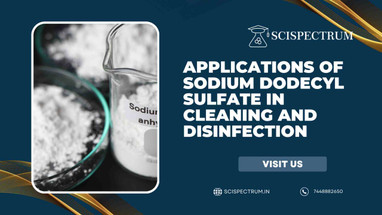Posted by Scispectrum on 22nd Aug 2025
Sodium Dodecyl Sulfate: The Cleaning Powerhouse in Your Home and Beyond
From sparkling dishes to spotless countertops, we rely on cleaning products to keep our homes and workplaces hygienic. But have you ever wondered about the science behind these cleaning miracles? One key ingredient found in countless cleaning and disinfection products is sodium dodecyl sulfate (SDS), a powerful surfactant with remarkable grease-cutting and microbe-fighting abilities. This article delves into the fascinating world of SDS, exploring its applications, benefits, and considerations for safe and effective use.
Unmasking the Cleaning Agent: What is Sodium Dodecyl Sulfate?
Sodium dodecyl sulfate, also known as sodium lauryl sulfate (SLS), is a synthetic organic compound belonging to a class of chemicals called surfactants. Surfactants are molecules with a unique structure – they possess both a water-loving (hydrophilic) head and a water-repelling (hydrophobic) tail. This dual nature allows SDS to interact with both water and oily substances, making it an exceptional cleaning agent.
The Science of Clean: How SDS Works
The cleaning power of SDS lies in its ability to reduce surface tension and break down greasy, oily, and organic matter. Here’s a closer look at the science behind its effectiveness:
- Micelle Formation: When SDS is added to water, its molecules self-assemble into tiny spheres called micelles. The hydrophobic tails of SDS molecules orient themselves towards the center of the micelle, while the hydrophilic heads face outwards, interacting with water molecules.
- Grease and Dirt Removal: When a cleaning solution containing SDS encounters grease or dirt, the hydrophobic tails of SDS molecules are attracted to the oily substances, effectively surrounding and encapsulating them within the micelles.
- Emulsification and Suspension: The hydrophilic heads of SDS molecules, still interacting with water, allow the now-encapsulated grease and dirt particles to be lifted away from surfaces and dispersed into the water, effectively removing them.
Beyond Cleaning: SDS as a Disinfectant
In addition to its cleaning prowess, SDS also exhibits antimicrobial properties, making it a valuable component in disinfectant formulations. SDS disrupts the cell membranes of bacteria and some viruses, effectively neutralizing them and preventing their spread.
Applications Across Industries
The versatile nature of SDS makes it a sought-after ingredient in a wide range of cleaning and disinfection products:
- Household Cleaning Products: SDS is a common ingredient in laundry detergents, dishwashing liquids, surface cleaners, and all-purpose cleaners. Its ability to cut through grease and lift away dirt makes it highly effective for various household cleaning tasks.
- Personal Care Products: SDS is also found in many personal care products, including shampoos, body washes, and hand soaps. Its foaming and lathering properties contribute to a desirable sensory experience while effectively removing dirt and oil from the skin and hair.
- Industrial Applications: SDS finds applications in industrial settings for degreasing machinery, cleaning equipment, and removing stubborn stains. Its potent cleaning action makes it suitable for heavy-duty cleaning tasks.
- Laboratory Settings: SDS is a crucial reagent in biochemical research, particularly in protein analysis. Its ability to denature proteins makes it an essential component in techniques like SDS-PAGE (sodium dodecyl sulfate-polyacrylamide gel electrophoresis), a widely used method for separating proteins based on their size.
Benefits of SDS in Cleaning and Disinfection
Several factors contribute to the widespread use of SDS:
- Effectiveness: SDS is highly effective at removing grease, oil, and dirt from various surfaces, making it a valuable cleaning agent for both household and industrial applications.
- Biodegradability: SDS is readily biodegradable, breaking down into less harmful substances in the environment. However, it’s essential to choose products with responsibly sourced and sustainable SDS.
- Cost-Effectiveness: SDS is a relatively inexpensive surfactant, making it an economical choice for manufacturers and consumers alike.
Considerations for Safe Use
While SDS is generally safe for use in cleaning products, certain precautions should be taken:
- Skin and Eye Irritation: SDS can cause skin and eye irritation, especially in high concentrations. It’s essential to use products containing SDS as directed and rinse thoroughly after use. Individuals with sensitive skin may want to opt for products with milder surfactants.
- Environmental Impact: While biodegradable, the production and disposal of SDS-containing products can still have environmental impacts. Choosing concentrated formulations, using appropriate dosages, and opting for environmentally responsible brands can help minimize these impacts.
- Proper Handling: When handling concentrated SDS solutions, it’s crucial to wear appropriate personal protective equipment, such as gloves and eye protection, to prevent accidental exposure.
Conclusion: A Cleaning Powerhouse with Responsibility
Sodium dodecyl sulfate plays a vital role in maintaining hygiene and cleanliness in our daily lives. Its remarkable cleaning and disinfecting properties make it an invaluable ingredient in countless products. By understanding the science behind its effectiveness and following safe handling practices, we can harness the cleaning power of SDS while minimizing potential risks and promoting environmental responsibility.

